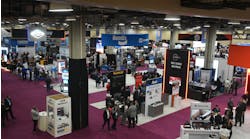Wabash’s new composite material could make refrigerated transportation a more efficient and green industry.
Transportation today faces constant pressure to become more energy efficient. With the manufacturer’s new composite technology, refrigerated transportation’s next big step in temperature control efficiency is happening in the very structure of the refrigerated body.
“The market has not seen a new way of constructing refrigerated truck bodies for half a century,” Kevin Sumrak, senior director of sales and truck body strategy for Wabash, said. “That’s why it’s something that’s really revolutionary in the refrigerated market today.”
At Wabash’s 2024 conference in Louisville, Wabash Ignite, the company displayed a medium-duty truck using the composite: the Wabash Acutherm refrigerated freight body with EcoNex Technology.
EcoNex, the company’s proprietary technology, replaces conventional refrigerated truck body construction, using what Wabash says is a significantly lighter and 25% more thermally efficient build.
Structure and insulation in one material
A significant benefit of the truck body’s EcoNex panels is the panels’ independent structural integrity.
Traditional refrigerated body builds generally use an insulating foam, such as Freon-blown urethane, for thermal efficiency and surround it with structural metal like aluminum posts and skins.
EcoNex composite panels, on the other hand, provide both thermal efficiency and structure in one package. The composite has the structural strength to meet operational needs without metal posts.
Comparing a traditional medium-duty truck body to one built with composite panels, a body built with EcoNex is roughly 15% lighter—equal to about 700 lb. of weight savings, Nick Clickenbeard, product manager for Wabash, told Trailer-Body Builders.
An added benefit of the composite panel is a smooth exterior.
“You’re not going to see any seams really on it because it’s all molded as one part,” Clickenbeard said. “That smooth exterior, especially with no seams, is great for decals. You don’t have the rivets sticking up.”
Smooth temperature profile
Overall, a refrigerated body using the EcoNex panels is roughly 25% more thermally efficient than a traditional body, according to Wabash.
These composite panels also provide a smoother temperature profile and slower degradation.
Traditional refrigerated bodies need metal posts in the walls for structural support, which leads to less consistent temperature control across the body.
“That’s a great way to conduct heat from the outside in,” Clickenbeard said.
Each metal post, less insulated than the rest of the body, brings a significant change in temperature for specific points in the body. With the composite panels using EcoNex technology, metal posts aren’t needed.
“There are so many fewer spots where you have that drastic change in temperature profile,” Clickenbeard said. “You have a much more consistent temperature profile across the body.”
Less moisture intrusion
The tight composition of a truck body using EcoNex panels also means less water intrusion, according to Wabash.
“With conventional construction, you actually have open areas on the ends where the wall would fit into the extrusions and other areas in the construction that allow water to penetrate the wall and get into the insulation,” Sumrak explained. “With EcoNex, you don’t have that.”
Read more: Collaborate to innovate
The construction of the composite panels, including the composite’s protective gel coat, introduces fewer voids in the body. The panels are then significantly less likely to absorb water over the life of the body, Sumrak said. Less moisture intrusion means even greater comparative thermal efficiency as the body ages.
Energy saved
Greater overall thermal efficiency means that fleets have to spend less energy powering transportation refrigeration units.
“Many of our fleets will run the refrigeration unit roughly 1,600 to 2,000 hours a year just to keep the product cold,” Clickenbeard explained. “That’s utilizing half a gallon of diesel per hour. If we say 1,600 hours a year and you improve 25% on that, that’s 400 hours that you’re not running your refrigeration unit.”
Smaller carbon footprint
A truck body using these composite panels saves more than just TRU hours.
Because a body using the panels needs no metal frame, manufacturing requires less metal production. Minimizing steel and aluminum production, both highly carbon-intensive processes, means a smaller carbon footprint for the vehicle.
Energy savings for the body also go beyond TRU use. With a lighter overall weight compared to traditional bodies (about 700 lbs.), the medium-duty truck body using EcoNex panels would require less fuel or energy to move.
With the onset of electric vehicles, limited range makes energy efficiency crucial, while heavy batteries make lightweight builds advantageous.
“It’s great for ICE engines, and I would say it’s even better for EVs,” Sumrak said.
Technology partners
Kroger embraced the panels’ effectiveness with what may be the technology’s biggest commercial application so far. The grocery giant now runs hundreds of refrigerated truck panels using EcoNex Technology on light-duty trucks.
The companies’ partnership started with a traditional RFP process. Kroger was seeking refrigerated truck bodies uniquely designed to fit its standards for weight, size, and TRU effectiveness.
Wabash had been working on commercializing its new EcoNex Technology in March 2020, when it entered the RFP process as an opportunity to introduce EcoNex to Kroger’s fleet.
At the time of the RFP, Kroger was bringing over a unique automated distribution model from Ocado. The company’s automated facilities support direct home grocery deliveries in multiple states. Kroger needed a light-duty commercial vehicle to deliver refrigerated produce efficiently. The refrigerated body needed to be effective but also sized according to the bins utilized in the Ocado model.
“The truck body that they were looking to purchase was very much developed around that technology,” Sumrak told Refrigerated Transporter, Trailer-Body Builder’s sister publication. “The intent was to have a very specific use case for these commercial vehicles.”
Wabash visited Kroger to better learn their operations and needs.
“When we were responding, our intent was to learn much more about their business and what their intent was,” Sumrak said. “We wanted to become a technology partner, not just a box provider.”
Weight reduction and thermal efficiency were both key factors for Kroger. Especially with the possibility of EV technology in the future, maximizing cargo capacity by reducing truck body weight was important.
“And that’s really where EcoNex Technology shines because, from a conventional type of refrigerated body construction, it’s up to 15% lighter and, additionally, it’s 25% more thermally efficient,” Sumrak said. “It really fit the bill for this exact use cast that Kroger had.”
Rapid development
Once Kroger chose Wabash, the company developed the refrigerated truck body very quickly.
“It’s probably one of Wabash’s greatest product development stories, to be honest,” Sumrak said. “From acceptance of the RFP by Kroger to the pilot phase and getting into production took us about eight months.”
Kroger installed the truck bodies on Ford Transits and E350s. The truck body interior is designed to hold a certain number of bins and maintains two different temperatures: 60 degrees F in the back and 32 degrees in the front.
Kroger is continuing to grow its distribution centers and delivery service across the nation. Meanwhile, Wabash is selling Kroger hundreds of units per year to build its fleet, according to Sumrak.











